
Prakt_kurs_angl_yazyka_2
.pdf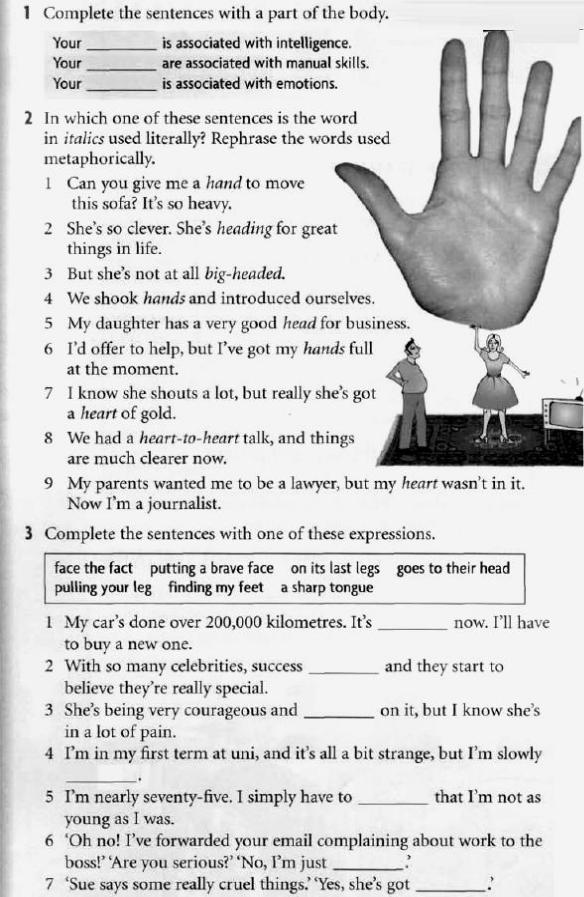
Vocabulary and Listening: Body Idioms
91
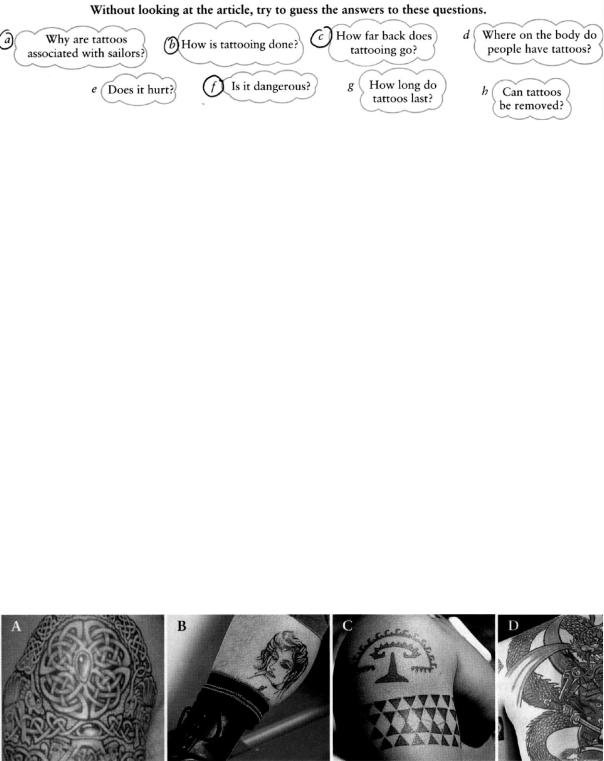
4. Listen to 3 conversations, replace some parts of them with the expressions from the previous page. Then listen and check if you were right.
Reading: Skin Deep
1. |
Match |
these |
words |
to |
the |
correct |
translation: |
1) on their return |
|
|
a) придерживаться чего-либо |
||||
2) a pattern |
|
|
b) посредством чего-либо |
||||
3) major styles |
|
|
c) узор |
|
|
||
4) an intricate knotwork |
|
d) на кончикe |
|
||||
5) a range of sth |
|
|
e) при условии что |
|
|||
6) to tend to do sth |
|
f) нерешительные люди |
|
||||
7) to display sth in public |
|
g) разжижать кровь |
|
||||
8) by means of sth |
|
|
h) касаться чего-либо |
|
|||
9) to dip sth into sth |
|
i) иметь тенденцию |
|
||||
10) on the tip of sth |
|
j) демонстрировать прилюдно |
|||||
11) to subside |
|
|
k) стихать, уменьшаться |
|
|||
12) to thin the blood |
|
l) oбмакивать |
|
||||
13) Provided that… |
|
m) выбор, ассортимент |
|
||||
14) to concern sth |
|
|
n) по их возвращению |
|
|||
15) the undecided |
|
|
o) основные стили |
|
|||
16) to stick to sth |
|
|
p) |
сложное |
переплетение (узор) |
||
2.Now read the article. What were the answers to the questions?
3.Translate the text and find in it equivalents to the following:
граница, современный, чернила, старение, замаскировать \ спрятать под чем-то, накрыть \ закрыть чем-то, пара, запрещать, постоянный, удалить\ убрать, полностью.
4.Which of the styles describes in the article do you think these tattoos are?
5.What problems might you have if you:
1.went to a 'scratcher'?
2.took aspirin before being tattooed?
3.tattooed the name of someone you're in love with?
92
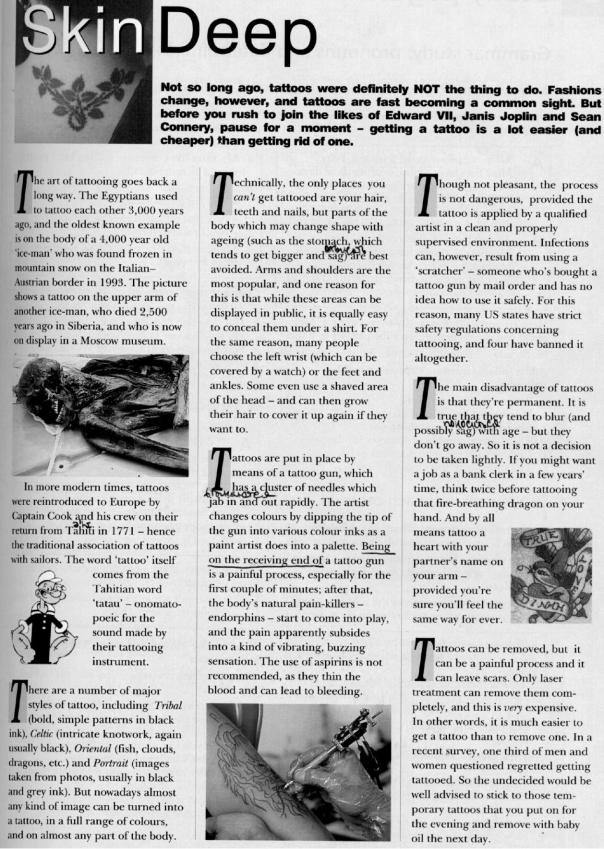
4. had a tattoo on your cheek? |
5. had a tattoo removed? |
6. Listen to the story. What problem did the speaker have with his tattoo?
93
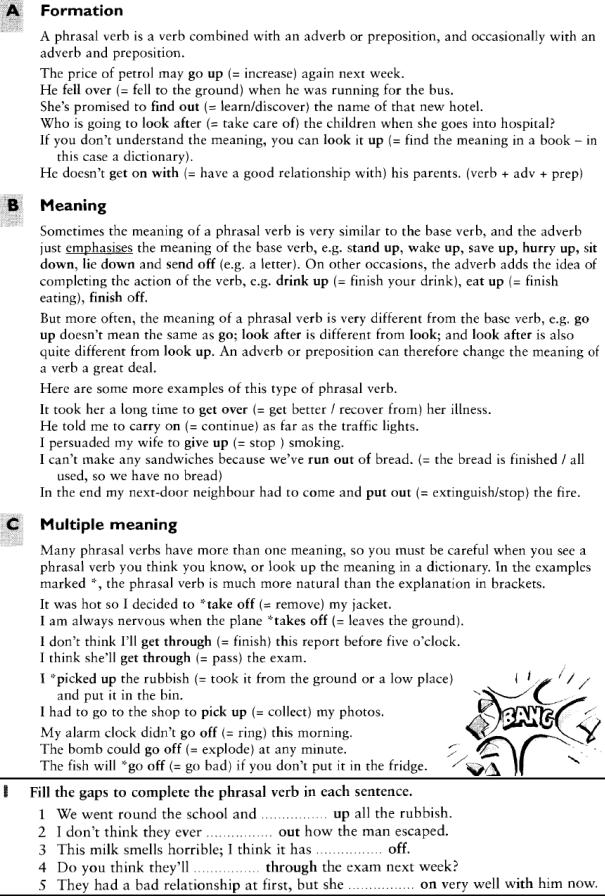
Grammar: Phrasal Verbs
94
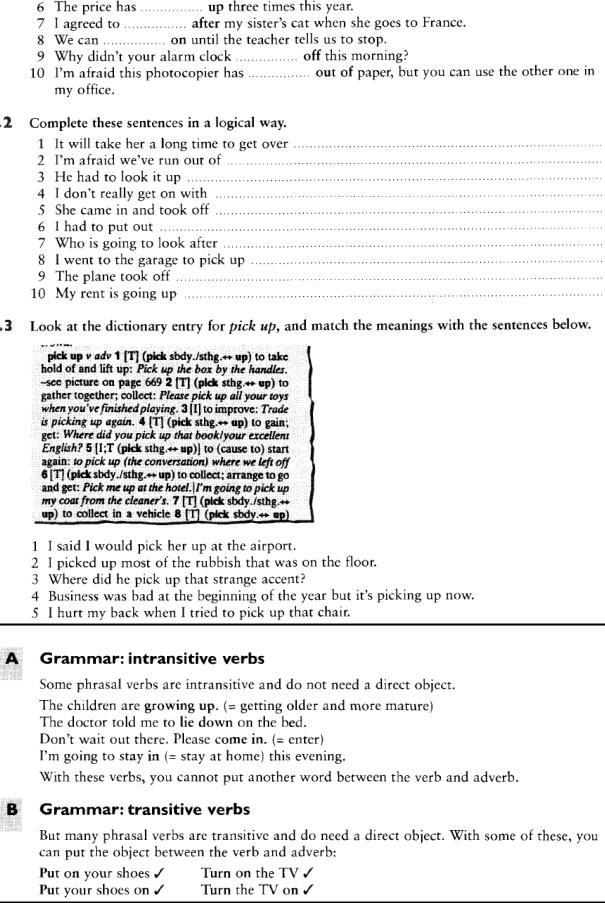
Grammar: The Structure of Phrasal Verbs
95
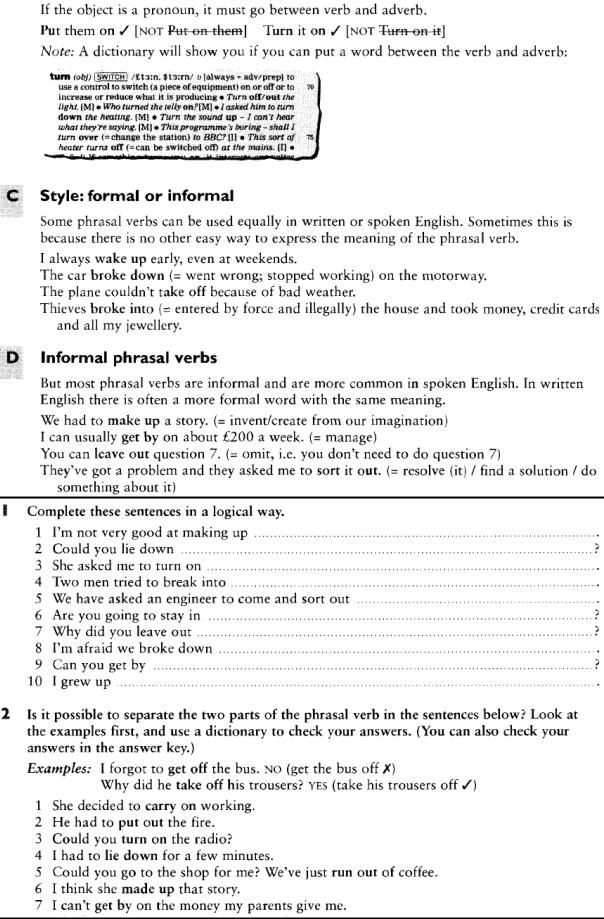
96
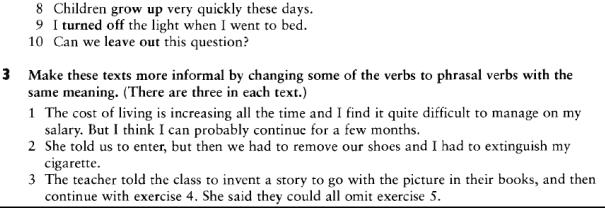
Grammar/Vocabulary: Phrasal Verb “to take”
take on |
брать на себя (работу, ответственность и т.д.) |
|
take up doing sth |
заняться каким-то новым видом деятельности |
|
take off |
1) |
снимать (a hat); 2) отправляться (о транспорте) |
take in |
1) |
понять, разобраться; 2) обмануть |
take to |
= to like sb / sth |
|
take over |
вступать во владение чем-либо, стать хозяином |
|
take (sth) down |
1) |
записать (= put down); 2) разрушить, сломать (здание) |
take sb for sb |
принять к-л за к-л |
|
1. In the table above find synonyms to the following:
to gain control over a company, to think that sb is a friend (when sb is not), to depart, to understand, to write down sb‘s telephone number, take a liking to sb, to deceive sb, to go to photography courses, to destroy a building.
2. Translate using point one (the style is informal, just like phrasal verbs sound in English):
1.Не ведись на рекламу. (use passive, дословно – не будь обманут рекламой)
2.Не стоило взваливать на себя столько работы.
3.Ну как Бегбедер, зацепило? (= понравилось?)
4.Ок, твои координаты я зафиксировал, увидимся в пятницу, пока.
5.Может, хватит уже его ждать, поехали?
6.Извини, я думал, это про тебя Марк говорил. Все равно держи визитку на всякий случай.
7.Ну так я и не сомневался в том, что этот скользкий тип подомнет под себя всю сеть!
8.Ты опять нашел себе очередное хобби?
9.Как-то не улавливаю я смысл этого правила.
3. Make up sentences in Russian for your partner to translate, use the word-combinations with “take” in the table below:
take one‘s chance |
воспользоваться шансом |
take an interest in sth |
(за)интересоваться ч-л |
take pains to do sth |
стараться, прилагать усилия |
Take it or leave it. |
Не хотите – ваше дело. |
|
97 |
take offence |
обижаться |
take sb by surprise = aback |
застать врасплох, обескуражить |
take sth / sb for granted |
воспринимать как само собой разумеющееся |
take one‘s time |
не торопиться |
take sth into account |
принимать во внимание, учитывать |
Reading: Mary Baker Eddy, Founder of the Christian Scientists
1.Read the text, find English equivalents to these vocabulary units and in your own words say in what contexts they were used:
домашнее обучение, включать в себя что-либо, полностью излечиться, основывать что-либо, вместо чего-либо, последователи, удерживать когото от совершения чего-либо, по всему миру.
2.Match the words to their translation, use it to help you understand the text:
1. |
as a child |
a. |
целитель |
2. |
scriptures |
b. |
новый завет |
3. |
a Gospel |
c. |
надзирать, контролировать |
4. |
the New Testament |
d. |
Евангелие |
5. |
a healer |
e. |
брать начало от, происходить от |
6. |
to oversee |
f. |
в детстве |
7. |
а sin |
g. |
священное писание |
8. |
to originate with sb / sth |
h. |
традиционный |
9. |
consequently |
i. |
грех |
10. conventional |
j. |
следовательно |
|
Mary Baker Eddy, Founder of the Christian Scientists
Mary Baker Eddy was an American religious leader and the founder of the Christian Science movement. She was born in Bow, New Hampshire (USA), on July 16, 1821. As a child she was not very healthy; as a result she missed a great deal of school. Her education came through home schooling and study of the Bible and scriptures.
She continued to suffer from poor health when she became an adult and tried many alternative therapies of the times. These included mesmerism (hypnosis),
hydrotherapy (water cures), and mental healing. Once, after falling on ice and suffering a severe injury, she asked for her Bible and read a Gospel account of one of Jesus's healings. After reading the New Testament, she was completely cured and felt she had finally found the answer to her medical problems: the scriptures.
Eddy believed that all sickness was mental rather than physical. She began the practice of healing others by reading the Bible and teaching others to be healers as well. In 1875 she published ―Science and Health with Key to the Scriptures‖. Eddy later published sixteen other books. In 1879 she founded the
98
Church of Christ, Scientist, an organization she oversaw closely until her death. Her followers, the Christian Scientists, believe that disease, as well as sin
and death, do not originate with God and consequently are not real. They see God as the only healer. Instead of medicinal remedies, Christian Scientists pray for the sick person. The church, however, does not stop its members from seeing a doctor; it leaves the choice to the individual. The church allows conventional therapy for "mechanical" problems such as broken bones and dental cavities.
Today there are more than 2,700 Christian Science churches worldwide.
3.Make a gist of the text, concentrating only on the most important facts.
4.Complete the following sentences individually and then discuss your answers with a partner.
1.Some people try nonconventional methods of healing because _______ .
2.Many people look to spiritual healing – reading religious scriptures – to help them get better because_________________________________ .
3.I agree (or disagree) with Mary Baker Eddy's philosophy that all sickness is mental rather than physical because_______________________________ .
5.Say why: a. Mary Baker Eddy was taught at home.
b.she tried many therapies when she became an adult.
c.she decided that reading the Bible and praying can improve people‘s health?
d.she published a book.
e. the Church doesn‘t stop its members from common therapies?
Reading: Norman Cousins's Laugh Therapy
1. Match these vocabulary units to the correct translation:
1. |
constantly |
a. |
уверенность |
2. |
to be determined to do sth |
b. |
быть решительно настроенным сделать |
3. |
to survive |
|
ч-л |
4. |
body chemistry |
c. |
постоянно |
5. |
confidence |
d. |
желание жить |
6. |
will to live |
e. |
извлечь, вызвать что-либо |
7. |
ailment |
f. |
внести в расписание |
8. |
to elicit sth |
g. |
подвергнуть сомнению |
9. |
to schedule sth |
h. |
внутренние процессы в организме |
10. |
alternative |
i. |
нетрадиционный, альтернативный |
11. to question sth |
j. |
болезнь, недомогание |
|
k.выжить
2.Read the text and find equivalents to these:
терапевт, анализы, неподвижный, преодолеть, вредить здоровью, преимущество чего-либо, в дополнение к чему-либо, улучшение.
Norman Cousins's Laugh Therapy
In the summer of 1964, a well-known writer and editor Norman Cousins became very ill. His body ached and he felt constantly tired. It was difficult for
99
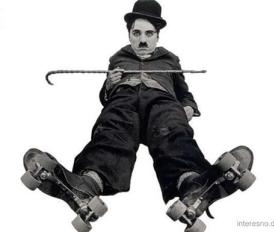
him to even move around. He consulted his physician, who did many tests. Eventually he was diagnosed as having ankylosing spondylitis, a very serious and destructive form of arthritis. His doctor told him that he would become immobilized and eventually die from the disease. He was told he had only a 1 in 500 chance of survival.
Despite the diagnosis, Cousins was determined to overcome the disease and survive. He had always been interested in medicine and had read the work of organic chemist Hans Selye, The Stress of Life (1956). This book discussed the idea of how body chemistry and health can be damaged by emotional stress and negative attitudes. Selye's book made Cousins think about the possible benefits of positive attitudes and emotions.
He thought, "If negative emotions produce (negative) changes in the body, wouldn't positive emotions produce positive chemical changes? Is it possible that love, hope, faith, laughter, confidence, and the will to live have positive therapeutic value?"
He decided to concentrate on positive emotions as a remedy to heal some of the symptoms of his ailment. In addition to his conventional medical treatment, he tried to put himself in situations that would elicit positive emotions. "Laugh therapy" became part of his treatment. He scheduled time each day for watching comedy films, reading humorous books, and doing other activities that would bring about laughter and positive emotions. Within eight days of starting his "laugh therapy" program his pain began to decrease and he was able to sleep more easily. His body chemistry even improved. Doctors were able to see an improvement in his condition! He was able to return to work in a few months' time and actually reached complete recovery after a few years.
Skeptical readers may question the doctor's preliminary diagnosis, but Cousins believes his recovery is the result of a mysterious mind-body interaction. His "laugh therapy" is a good example of one of the many alternative, or nonconventional, medical treatments people look to today.
3. Answer the questions:
1.What did Norman Cousins mean by "a positive attitude in healing"?
2.What can you do to have a positive attitude to life?
3.Why do you think Charlie Chaplin could be associated with a positive attitude and healing?
4.If you were a doctor and prescribed your patient a list of comedies, what would be top five?
100
